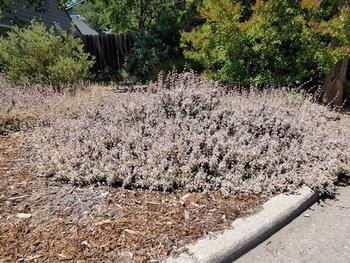The Latest Dirt - July 2023
Bee's Bliss Unhappy in Pleasant Hill
By Stephanie Hargrove
Client’s question: I’m wondering if I should prune back my Salvia Bee’s Bliss, I live in Pleasant Hill. The leaves yellowed after the winter, and I thought it was due to too much moisture from the winter rain. Now it’s dried out, so maybe I didn’t give it enough water this spring? How hard should I prune it back, and can I do it now or wait until fall?
Stephanie Hargrave’s reply:
Thank you for contacting the UC Master Gardener Program Help Desk regarding pruning your Salvia ’Bee’s Bliss.’

This will be a careful experiment unless you can find a nursery person who is experienced with this plant and can tell you about their experiences and recommendations!
So, let’s see what we can do to help you! First, I would check to see if fresh new growth is coming up at the base of the plant. If there appears to be fresh growth, try pruning off some of the dead materials, but do not cut down to the ground. Clip the spent stem before the last set of green leaves. If you don’t see green, gently wiggle the stems to see if they pull out of the ground or break off. Remove stems that appear to be dead. At this point, you’re simply trying to expose the new growth to air and sun and hopefully cut off spent, unneeded woody stems. Now wait to see what happens with the plant! It should begin to put out vigorous growth.
Here are pruning instructions from the Waterwise Garden Planner website in Southern California for Bee’s Bliss: “Generally, bee’s bliss sage requires little to no maintenance after establishment but can be pruned if desired. When young, pinch back growth near the center of the plant to encourage a nice ground cover form and prevent a lumpy mounding form. If pruning is desired, after spring / early summer flowering can be headed back by removing as much of the new–ish growth as desired. Doing so immediately after the first bloom encourages subsequent blooms… Cut back by up to 1/3 to 1/2 or more of the leafy part of the branches in fall to keep compact form; just make sure to leave at least two leafy nodes per branch as plants might not push new growth if cut below leafy nodes into old wood. Salvia’ Bee’s Bliss’ can be prone to powdery mildew. It is often a seasonal issue in the winter to spring, which will go away in warmer weather. If mildew is a persistent problem, it is not worth using fungicides, but better to replace them with a more suitable plant for the site.” conditions. https://waterwisegardenplanner.org/plants/salvia–bees–bliss/
Be sure to check for powdery mildew symptoms, as this may be preventing the plant from thriving: https://ipm.ucanr.edu/PMG/PESTNOTES/pn7493.html
Information about Bee’s Bliss from our Master Gardener friends in San Luis Obispo: https://ucanr.edu/blogs/blogcore/postdetail.cfm?postnum=27556
Calscape information: https://calscape.org/Salvia–x–%27Bee%27s–Bliss%27–(Bee%27s–Bliss–Sage)
I hope this information is useful to you. Many of us who grow salvias have learned how to best prune by trial–and–error year over year, so you’re not alone in wondering what to do with your beautiful plant! Good luck! And let me know if you have any additional questions.
